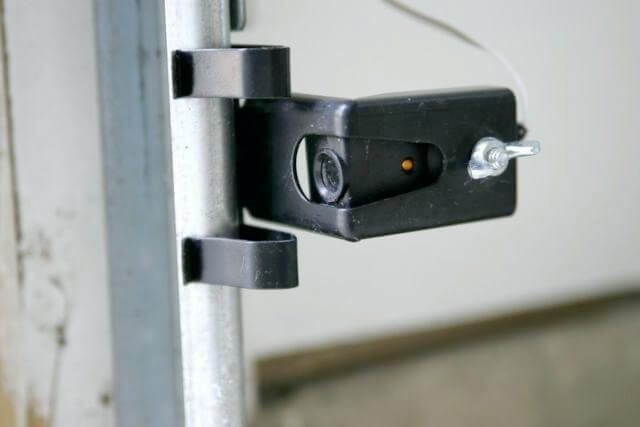When your garage door isn’t working right, it’s a major inconvenience. And, while it’s tempting to save time and money by trying to fix it yourself, certain repairs can only be done by a garage door professional who has the tools and training to do it safely and correctly.
How do you know whether to do it yourself or call in a pro? Check our symptoms and solutions list below.
Garage Door Problems Homeowners Can Fix in Minutes
1. My Garage Door Doesn’t Close All The Way
If your garage door won’t close all the way, there may be an issue with the photo eye, a safety feature that uses an infrared beam to prevent your garage door from closing on a person, pet or other object in its path.
If the photo eyes are misaligned or blocked, your garage door will stop closing before it reaches the floor and reverse open. The light in your garage door opener will blink on and off rapidly when this happens.
To fix it:
- Adjust the pivot bracket so the photo eyes are parallel.
- Make sure nothing stored near the garage door is blocking the sensor’s infrared beam such as toys, tools, or bikes.
- Remove cob webs, dirt, moisture or debris from the photo eye units.

Photo eyes are mounted and aligned 6” from the floor on both sides of the garage door.
Ensuring that the sensors function, stay parallel to one another, and have nothing blocking them is an easy fix that takes less than five minutes and avoids an unnecessary service call.
2. Fixing a Noisy Garage Door
Noisy garage doors are usually caused by worn rollers, loose hardware, or metal parts that need lubrication -- all simple fixes.
You may need to call a garage door repairman if your garage door is still making loud noises after you tighten and lubricate the metal parts.
- Spray the springs, roller bearings (on rollers with metal wheels) and hinges, and lift cables with a garage door lubricant every two or three months. Note: Do NOT lubricate nylon rollers without bearings, that can damage the roller.
- Tighten any loose nuts and bolts on the garage door and track.
- Look for worn rollers and hinges and replace them if necessary.

Clopay Pro Lube no-drip synthetic formula comes in 9 oz. can with a convenient spray applicator and extension tube. It is an anti-friction, rust-resistant formula with no harmful solvents, and can be used for other home, auto, and marine applications.
Clopay also offers a QuietFlex Hinge designed to cut garage door noise in half.

Clopay’s QuietFlex Hinge cuts garage door noise in half.
The QuietFlex Hinge has self-lubricating nylon bushings that help eliminate metal to metal contact on the hinge, reducing noise, door binding, and daily wear and tear when the door is opened and closed. Homeowners will notice a difference, particularly on larger, heavier doors.
3. Do It Yourself Garage Door Cleaning
Cleaning the exterior surface of your garage door will improve your home’s curb appeal and prolong the life of the door.
- Use mild dish soap and a wet cloth, sponge or soft bristle brush to wash your door. Rinse it thoroughly with clean water.
- To protect a steel garage door from corrosive salt air and maintain the finish, apply a spray-on car wax to the surface twice a year.
- Clean regular glass garage door windows with a non-abrasive cleaner like dish soap or vinegar and water. For Lexan or decorative windows, refer to these instructions.
- While you’re in cleaning mode, go ahead and clear any debris build-up out of the track and lubricate all of the metal parts.
Refer to the care and maintenance manual that came with your Clopay garage door for cleaning instructions specific to your model.
4. Leave Broken Garage Door Spring Repair to the Pros
A broken garage door spring is one garage door repair that you should NEVER attempt to do yourself. Always call a professional.
The first clue that you have a broken garage door spring is often the startling sound of a loud bang coming from the garage.

When a garage door torsion spring breaks, the coil separates into two pieces leaving a gap in between that is sometimes several inches wide.
Garage door springs are wound under high tension that can release and cause injury or property damage. When they break, the spring unwinds in less than a second and creates a loud noise due to the coils spinning on the shaft.
Here are some other likely signs of a broken garage door spring:
- The garage door opens a few inches but then it stops and won’t go any further.
- The garage door won’t open even when you pull the red emergency release cord.
- The top section of the garage door is bent.
Replacing a broken spring is a common repair and most professional garage door companies offer emergency service so your car isn’t stuck inside the garage or worse yet, buckled in the opening.

Depending on the extent of the damage, garage door spring replacement usually takes 30 minutes to an hour. A reputable dealer will show you exactly what parts need to be replaced and provide a quote prior to starting the job.
Need a professional garage door repair technician?
Find your local garage door service provider by using our Dealer Locator.
READ MORE ABOUT GARAGE DOOR REPAIRS: